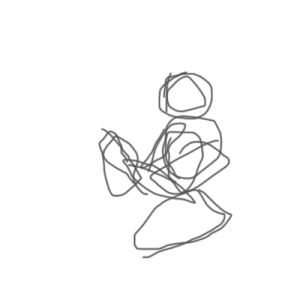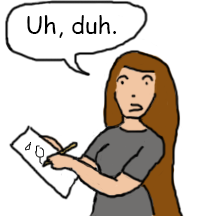During the write-a-thon, I found myself looking for the shapes of stories – the very vaguest, simplest structures I could find. Something to start with, like an artist starts with an outline or sketch. When you’re in a crunch to produce a complete work, it helps to have an idea of its completeness to start – a vision of what it will be, the dimensions it will occupy in space so you know where to start and where to end.
Think about back when you drew as a kid – how many times did you start a drawing and find there wasn’t enough room to complete it on the paper? Then you learned in art class to draw a circle first, to sketch out the vague shape first, centered on the page. It’s the same with stories. Sure you can just start writing and see what comes out, but if you intended your “paper” size to be a short story, you can easily find yourself running off the edges.


Almost immediately a friend asked me if I had any story shapes, then, that I could lend him. I laughed because, of course, my journal notes have been nothing BUT trying to define these shapes now that I’ve latched onto them as a productivity tool.
So, the first shape I approached was perhaps one that feels the most complex: The Crime Caper. I love capers, and I love a caper plot. I looked at four crime caper movies I love. After all, a movie has about as much story as a short story.
- Lock, Stock and Two Smoking Barrels
- Layer Cake
- Sneakers
- Usual Suspects
I admired my list, thinking, “Yes, these are four stories that have similar shapes.”
Let’s look at what these stories have in common:
A large cast of characters embroiled together to chase some goal, or related goals or competing goals.
A mcguffin.
Double-crosses and complications and dramatic irony.
Lots of fall out, violence and death. In the end, either everyone but the heroes or well, everyone dies.
The pleasure in these stories is that sensation of almost not quite losing track of the plot, of figuring things out seconds before the reveal. Almost all the characters are immoral, willing to do terrible things for their ends.
Irony is also key. Dramatic Irony – the characters not knowing information the audience does. In Lock, Stock and Two Smoking Barrels, almost no one knows that the two guns being bartered and traded around are the most valuable treasure to be had. In Layer Cake, the irony is Situational. Our nameless main character wants just to get out of crime, has done everything carefully, and despite brilliant maneuvering as each twist of the plot takes him further from the goal, he is killed in the last seconds for the one non-illegal thing he did in the film.
SO… to write a Caper story. Make a McGuffin, create at least three distinct people or factions who want it. Bonus points if they want it for different reasons. Have two join together despite opposition to get it and then one betrays the other so he allies with the third and then betrays him – mix that up as much as you want. Twist, twist, repost, complicate… it sounds exhausting to plot out but it doesn’t have to be.
Harry is told he needs to get the X by Saturday or a mob boss will kill him. In desperation he enlists the help of his crazy ex-girlfriend, Cher. Her current lover is a wacky character who, out of jealousy, tips off the owner of X. Harry’s plan starts with the audience knowing it’s going to be wrecked but, surprise! Harry bet on that happening and has staged a secret plan to extricate himself and X. However, this pisses off Cher and she dramatically steals X back. Now Harry is in league with X’s original owner to get it back, but wacky boyfriend tries to get Harry out of it and original gangster kills wacky boyfriend, resulting in Cher killing the gangster, and Harry makes off with X, just in the nick of time.
… something like that.
The point is: the moment you open a story with “Hey let’s rob a bank/casino/evidence locker” you are making a promise to your readers. They want to see an elaborate plan go awry and be replaced with a more elaborate plan, and all along they are expecting a certain type of ending: the plot resolves for good or ill, either the righteous bloodbath reaffirms our belief that Crime Doesn’t Pay or we get that sneaky joy when the protagonists get away with their bad behavior.
I realized that a certain unsold story of mine was a Caper. It even opens with a character saying to another “I need your help to do a caper.”
I had a hard time giving the story an ending. At some point in the revision process I decided it was really about forgiveness and I ended the story with the main character forgiving someone who had wronged him.
This was not a caper ending. I had given it the ending of an Epiphany Story. Of course it felt hollow and cheap. A Caper needs the resolution of the caper, it needs the McGuffin’s final position confirmed, and it needs a measure of irony.
I was afraid of writing my ending. I said I didn’t know how to write it – I couldn’t write a caper! Those are complicated! And I never intended to write one! – but the minute I wrote “Let’s pull a heist” there was an expected ending: They get away with it or they don’t.
This is how knowing the shape of a story helps. I was struggling to pull all these possible endings – any type of ending of any story – when in reality I could have just tried on these two. Did I want them to get away with it? Yes. How?
“What would be ironic?” I asked.
Once I had that – how the story ought to end and what question to ask to get there – the rest was just connecting dots and smoothing over the changes in the narrative.


